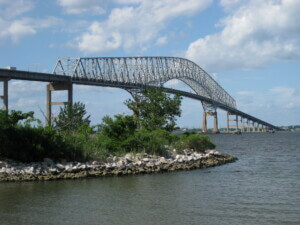Ever since the tragic collapse of the I-35 bridge in Minneapolis in 2007, politicians and public authorities nationwide have been scrambling to get theirs up to code. New bridges, or at least proposals for them, abound, some nice, some not so much. Fortunately, the Port Authority appears committed to a high-design bridge. The authority released a request for information [PDF] this week, a precursor to an RFQ. The Observer picked up on the PA’s interest in building the thing with a public-private partnership, an approach with a mix of benefits—no upfront costs—and risks—less control or long-term revenue. But what is promising, nonetheless, is the PA’s commitment to constructing what could be called a statement bridge.
It’s a pretty strong commitment, especially for an agency with an uneven track record—consider the World Trade Center, JFK, and the loathsome bus terminal. The design requirements, along with these handy renderings, are put thusly in the RFI:
The appearance of the structure is of great importance to the Authority, and the illustrative design has been subject to considerable attention as regards visually significant elements such as pier shape and cable layout. However, the “illustrative design” has been presented at public meetings with the proviso that it may be subject to amendment.
The Authority is developing aesthetic requirements to clearly define unacceptable
solutions (e.g. “smokestack” pylon design) and help Proposers determine the range of design solutions that may be acceptable. Aesthetic guidelines will cover overall form and function and matters such as edge detailing and finishes that are not yet reflected in the Authority’s “illustrative design.The Authority expects to assign some weight to a DBFM [design, build, finance and maintain] Company’s “visual management plan” which would provide detailed commitments on how aesthetic quality would be taken into account in the detailed design.
While we’re still trying to figure out what a “smokestack pylon” is, that there are unacceptable designs is at the very least a promising sign, as there will be no race to the bottom, an especially risky proposition with public projects. The prioritization of pedestrian and bicycle access as well as room for a future transit component running down the middle is a nice touch.
Granted, such design guidelines are probably a necessity given that the PA will be giving up some control over the project as a result of its undertaking a public-private partnership. Still, given that this may be the new normal, at least for the time being, as the PA continues to commit more money and time at Ground Zero, it’s good to see the agency taking a smart, aesthetically driven approach, one that will hopefully persist on sister projects.










